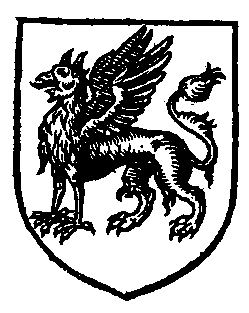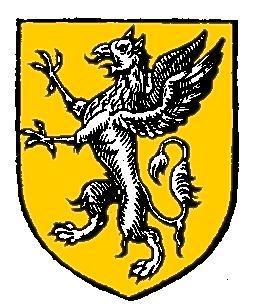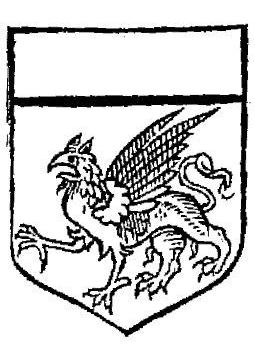CHAP. XI.
Of Griffins.
THAT there are Griffins in Nature, that is a mixt and dubious Animal, in the fore-part resembling an Eagle, and behind the shape of a Lion, with erected ears, four feet and a long tail, many affirm, and most, I perceive, deny not. The same is averred by Ælian, Solinus, Mela, and Herodotus,[1] countenanced by the Name sometimes found in Scripture,[2] and was an Hieroglyphick of the Egyptians.[3]
Notwithstanding we find most diligent enquirers to be of a contrary assertion. For beside that Albertus and Pliny have disallowed it,[4] the learned Aldrovandus hath in a large discourse rejected it; Mathias Michovius who writ of those Northern parts wherein men place these Griffins, hath positively concluded against it; and if examined by the Doctrine of Animals, the invention is Monstrous, nor much inferiour unto the figment of Sphynx, Chimæra, and Harpies, for though there be some flying Animals of mixed and participating Natures, that is, between Bird and quadruped, yet are their wings and legs so set together, that they seem to make each other.[5] For though some species there be of middle and participating Natures, that is, of Bird and Beast, as Bats and some few others, yet are there parts so conformed and set together, that we cannot define the beginning or end of either; there being a commixtion of both in the whole, rather then an adaptation or cement of the one unto the other.
Now for the word γρύψ or Gryps, sometimes mentioned in Scripture, and frequently in humane Authors, properly understood, it signifies some kind of Eagle or Vulture, from whence the Epithete Grypus for an hooked or Aquiline Nose. Thus when the Septuagint6 makes use of this word, Tremellius and our Translation hath rendered it the Ossifrage, which is one kind of Eagle. And although the Vulgar Translation, and that annexed unto the Septuagint, retain the word Gryps, which in ordinary and school construction is commonly rendred a Griffin, yet cannot the Latine assume any other sense then the Greek, from whence it is borrowed. And though the Latine Gryphes be altered somewhat by the addition of an h, or aspiration of the letter π, yet is not this unusual; so what the Greeks call τρόπαιον, the Latine will call Trophæum; and that person which in the Gospel is named Κλέοπας, the Latines will render Cleophas. And therefore the quarrel of Origen was unjust, and his conception erroneous, when he conceived the food of Griffins forbidden by the Law of Moses: that is, Poetical Animals, and things of no existence.[7] And therefore when in the Hecatombs and mighty Oblations of the Gentiles, it is delivered they sacrificed Gryphes or Griffins; hereby we may understand some stronger sort of Eagles. And therefore also when 'tis said in Virgil of an improper Match, or Mopsus marrying Nysa, Jungentur jam gryphes equis;[8] we need not hunt after other sense, then that strange unions shall be made, and different Natures be conjoined together.
As for the testimonies of ancient Writers, they are but derivative, and terminate all in one Aristeus a Poet of Proconesus; who affirmed that near the Arimaspi, or one-eyed Nation, Griffins defended the Mines of Gold. But this, as Herodotus delivereth, he wrote by hear-say; and Michovius who hath expresly written of those parts, plainly affirmeth, there is neither Gold nor Griffins in that Country, nor any such Animal extant; for so doth he conclude, Ego vero contra veteres authores, Gryphes nec in illa septentrionis, nec in aliis orbis partibus inveniri affirmarim.[9]
Lastly, Concerning the Hieroglyphical authority, although it nearest approach the truth, it doth not infer its existency. The conceit of the Griffin properly taken being but a symbolical phansie, in so intollerable a shape including allowable morality. So doth it well make out the properties of a Guardian, or any person entrusted; the ears implying attention, the wings celerity of execution, the Lion-like shape, courage and audacity, the hooked bill, reservance and tenacity. It is also an Emblem of valour and magnanimity, as being compounded of the Eagle and Lion, the noblest Animals in their kinds; and so it is appliable unto Princes, Presidents, Generals, and all heroick Commanders; and so is it also born in the Coat-arms of many noble Families of Europe.[10]
But the original invention seems to be Hieroglyphical, derived from the Egyptians, and of an higher signification. By the mystical conjunction of Hawk and Lion, implying either the Genial or the sydereous Sun, the great celerity thereof, and the strength and vigour in its operations. And therefore under such Hieroglyphicks Osyris was described; and in ancient Coins we meet with Gryphins conjointly with Apollo's, Tripodes and Chariot wheels; and the marble Gryphins at Saint Peters in Rome, as learned men conjecture, were first translated from the Temple of Apollo. Whether hereby were not also mystically implied the activity of the Sun in Leo, the power of God in the Sun, or the influence of the Cœlestial Osyris, by Moptha[11] the Genius of Nilus, might also be considered. And then the learned Kircherus, no man were likely to be a better Oedipus.[12]
NOTES
* [My or others' notes are in square brackets]; Browne's marginalia is unmarked; {passages or notes from unpublished material by Browne is in curly braces}. Ross devotes a chapter to defending what he takes to be the ancient opinion, Arcana Microcosmi, Book II, Chap. 20, with a slight further defense in Chap. 10, which somewhat contradicts the fuller explanation. For a 19th-century theory relating the Griffin to a (more or less hypothetical) European tapir, see Timbs on Griffins.
1 [Aelian, De natura animalium, lib. IV, cap. XXVII; Solinus, xv; in Golding's (1587) translation, part of Chap. XXIV; Pomponius Mela, De chorographia II, [1], in Golding's (1585) translation, II.1; Herodotus, III.116 (where Herodotus notes he doesn't believe in the Arimaspoi) and IV.13 (where Herodotus notes the story is in conflict with other reports), and read the comment of How & Wells, Commentary on Herodotus, "grupas", which notes the transference of the griffins to India in Ctesias (see Aelian, above).]
2 [E.g., Lev. 11:12, in the Vulgate: "haec sunt quae de avibus comedere non debetis et vitanda sunt vobis aquilam et grypem et alietum"; translated as "ossifrage" in the KJV.]
3 [The hieroglyphic griffin is from Pierius, based on the Bembine table (see chapter VII notes. Pierius (1602) Hieroglyphica, (pp. 233-234): Exigere videtur rerum series, ut qui ab olore Phoebus aliæ exorsi sumus, Gryphes identidem Appollineos subiungamus: tametsi quid hi sibi vellent, numquam compererim apud Ægyptiorum hieroglyphicorum interpretes. Ægyptium tamen esse commeatum Bembæ ostendit tabula, in qua Gryphes multis variisque formis caelati, & ea etiam quam fabulantur effigie conspiciuntur....]
4 [Pliny, HN x(136) (englished), where they are paired with flying horses as fabulosities (and placed in Ethiopia rather than Scythia); vii(10) (englished), where the stories of Herodotus and Aristeas are recounted, with a distinctly disbelieving tone (and the griffins are in Scythia). Albertus xxiii.24???]
5 [That is, as Browne explains, the leg and wing are identical, or serve one for the other.]
7 [Origen De principiis (= Peri Archon), IV, 2, 17 (no local links, alas). Voltaire also made great use of the Mosaic proscription against eating "griffins".]
8 [Eclogues 8.27.]
9 [Maciej z Miechowa, or Miechowita, in his De duabus Sarmatiis (1518).]
10 [Guillim gives two instances, of the Haltons (Argent, a griffin passant, his wings displayed sable, armed gules), and notes that one Leigh adds the word "sergreant"; and of the Morgans, Or, a griffin rampant, with wings displayed sable. Guillim goes on to note "The erecting of the fore-legges of this Griffon, is an evident testimonie of his readinesse for action, which addeth a second force to his attempt, and promiseth a successefull event of his enterprise, by reason that hee uniteth force and industrie together. The Griffon having attained his full groweth, will never be taken alive; wherein hee doth Adumbrate or rather lively set forth the propertie of a valorous Souldier, whose Magnanimitie is such as hee had rather Expose himselfe to all dangers, and even to death it selfe, then to become captive." (J. Guillim (1610) A Display of Heraldrie, sect. III, chap. 26 (p. 181). Payne Fisher's 1682 Synopsis of Heraldry gives the Morgans (the Welsh Morgans), Or, a Gryphon segriant Sable. The 1664 edition of Guillim adds several more blazons with griffins, as that of the family Evelyn (including John): Azure, a Griffin passant, and a chief, or.

Hatton.

Morgan [of Wales].

Evelyn.
11 [Mophta Leoniformis. Pierius does not mention Osiris; Horapollo has no griffins.]
12 [I.e., no one is more likely to solve this riddle than Kircher.]
This page is dedicated to the memory of Boo the Cat.
